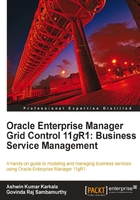
What this book covers
Chapter 1, Business Service Management: An Overview, you will get a brief introduction of the business service management space. This will include a brief overview of today's data centers, followed by industry standard guidelines for managing the complexities. It will also touch upon the Information Technology Infrastructure Library (ITIL v3) guidelines on business service management.
Chapter 2 , Modeling IT Infrastructure Using Oracle Enterprise Manager 11gR1, will introduce Oracle Enterprise Manager related concepts such as Targets, Metrics, Alerts, Beacons, Service Tests, and so on. This will be followed by an introduction to System and Service target types. It will also cover the definitions of various features such as Availability management, Performance management, and Service-Level Management.
Chapter 3, Modeling Groups and Systems, will present the OEM Grid Control capabilities in IT infrastructure management. Modeling IT infrastructure is a key precursor to passive management of data center services. OEM Grid Control offers capabilities to model IT infrastructure as systems, groups, and redundancy groups. We will cover all the three areas with a thrust on systems modeling, that is, in-depth coverage of the definition and configuration steps involved in setting up and monitoring a system target in OEM Grid Control.
Chapter 4, Modeling Services, will expand on the concept of service targets and the various options available to model them like generic service target, web application target, forms application, and so on. In particular, this chapter will introduce the steps involved in creation of a generic service target based on passive monitoring using system target through both the GUI and command line. It will also give a detailed overview of the various monitoring capabilities of service targets.
Chapter 5, Service Modeling Using Synthetic Transactions, will dive deeper into the area of active monitoring using beacons and service tests. The topics covered include extensive capabilities of the beacon target. It will also detail out the creation and monitoring steps of various service test types such as Host Ping, FTP, Web Service, and so on. The other areas covered include advanced synthetic transactions such as web transactions using the out-of-box recorder and playback. The service availability dependency on key tests and key beacons will also be covered.
Chapter 6, Modeling Service Metrics, will dive deep into the KPI modeling aspects of service targets in OEM. The KPIs are modeled as Service Metrics and are promoted from the underlying system and tests, as performance and/or usage metrics. This process of metric promotion will be covered at length. In addition, this chapter will also focus on setting thresholds on the service metrics so as to generate warnings and critical alerts.
Chapter 7, Service-Level Management, you will be provided with a walk through on the service-level management features in OEM Grid Control. This will include defining service-level rules and calendars as well as the impact of service alerts and blackouts on the service-level computation. It will further explore the service-level monitoring capabilities within OEM Grid Control.
Chapter 8, Modeling Composite Business Services, will cover the OEM capabilities in modeling and monitoring complex business services as aggregate service targets. It will explore the steps involved in defining and monitoring aggregate service targets. In addition, this chapter will cover metric promotion and service-level rules in the context of the aggregate service.
Chapter 9, Real-Time Business Service Monitoring, will cover the OEM Grid Control capabilities specifically in the real-time monitoring space. It will highlight the features of the OEM Grid Control reports and describe the features of dashboards for groups, systems, and services. It will conclude with a detailed discussion on desktop widgets.
Chapter 10, Business Service Management at Your Data Center, will provide some of the best practices and recommendations around Business Service Management with OEM Grid Control. The chapter will bring together the earlier chapters with a focus on providing real world scenarios where the various target types covered in the earlier chapters can be applied. The chapter will also cover some of the techniques for modeling a hierarchy of business services. It will also provide the various best practices to monitor the business services using the management by exception philosophy. The chapter finally concludes with an introduction to some of the service lifecycle management features available in OEM Grid Control 11gR1.